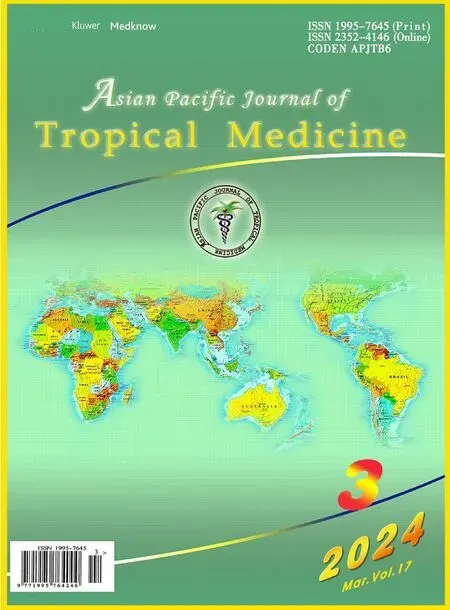Smoking of Carica papaya in Nigeria: The rationale,the public health effects and policies for intervention
2024-05-18AbolajiPaulAdekeye
Abolaji Paul Adekeye
1Mental Health Department,Federal Teaching Hospital,Ido-Ekiti,Ekiti State,Nigeria
2Mental Health Department,Afe Babalola University,Ado-Ekiti,Ekiti State,Nigeria
Psychoactive substance use is characterized by the habitual use of substances that have significant effects in altering the activities of neurotransmitters in certain regions of the brain.Consequently,these alterations manifest as cognitive,emotional,perceptual and behavioural changes in affected individuals[1].The use of psychoactive substances in Nigeria is an agelong entity as the licit substances like alcohol and tobacco and the illicit ones like cannabis,cocaine and heroine are regularly being used and misused[2].
Substance use disorders are of global health concern as they are part of the Neurological,Mental,Developmental and Substance group of disorders earmarked for attention by the World Health Organization through the mental health gap action programme and they contribute to the global burden of disease.The annual global prevalence of psychoactive substance use among adult population of over 18 years was reported as 5.6%,while in Nigeria,it was 14.4% with an average age of onset of 13 years.Apart from alcohol,cannabis is the most used substance,while cocaine is the least used in Nigeria[3].
Historically,pawpaw was introduced to Africa from Central America in the sixteenth century,and its medicinal properties are used locally in Nigeria for inflammation,depression,ageingetc.However,Carica papaya-pawpaw leaf,as a psychoactive substance is used as a close substitute to cannabis in Nigeria[2].In a cross-sectional study conducted in Southwest Nigeria,47.0%of respondents (undergraduates) smoked dried pawpaw leaves for euphoria and 43.4% affirmed that it gives similar feelings of euphoria and pleasure like cannabis[3].Considering the neurobiology of substance use,because pawpaw leaves give feelings of pleasure like cannabis,it can then be deduced that it causes a ‘dopamine rush’in certain brain regions especially in the nucleus accumbens and this consequently results in positive reinforcement,maintaining activities that support the further use of the substance[4].This is a major population mental health concern for the nation as pawpaw is a common fruit consumed by all and sundry in the country and putting a sanction on its plantation would be a futile move[5].
Besides,as pawpaw leaves are used as close substitutes to cannabis,it leaves more to imagine that it would foster the continued use of cannabis and further increase the risk of cannabis-related psychiatric disorders.Studies have shown that there’s a 2.5 times increased risk for schizophrenia among people that take cannabis and this is increased by five times among heavy users.This risk is significant among people with family histories of schizophrenia[4].This would heighten the disease burden for schizophrenia and cause a ripple effect on the level of community and national productivity[6].
Recommendations for public policy are as follows:
1.Pawpaw leaves should be added to the list of psychoactive substances that would be catered for in the national drug policy[2].
2.Adequate population mental health promotion should be done at all tiers of the government with the view to sensitize and inform the populace about the psychoactive properties of pawpaw leaves and its use as a close substitute to cannabis[3].
3.Mental health professionals should update their knowledge in the area of provision of psychological treatments for substance use disorders as pawpaw leaves deserve particular mention in the course of treatment delivery[6].
In conclusion,the use of pawpaw leaves as a psychoactive substance in Nigeria is premised upon its cannabinoid-like euphoric effects.It is of significant population mental health concern and adequate national policies can modify the effects on the burden of psychiatric disorders.
Conflict of interest statement
The author declares that there is no conflict of interest statement.
Funding
The authors received no extramural funding for the study.
Publisher’s note
The Publisher of theJournalremains neutral with regard to jurisdictional claims in published maps and institutional affiliations.
杂志排行
Asian Pacific Journal of Tropical Medicine的其它文章
- Mitigating fire risks in hospitals: Are we primed and geared up?
- Navigating the future of malaria control: Insights from India's pioneering malaria slide bank
- Dengue hemorrhagic fever with rectus sheath hematoma: A case report
- Characteristics of hospitalized patients with confirmed COVID-19 and their hospital management
- Prevalence and risk factors associated with long COVID symptoms in children and adolescents in a southern province of Vietnam
- Epidemic management in a measles outbreak in 2023,the return of vaccinepreventable diseases: A single center,retrospective observational study
